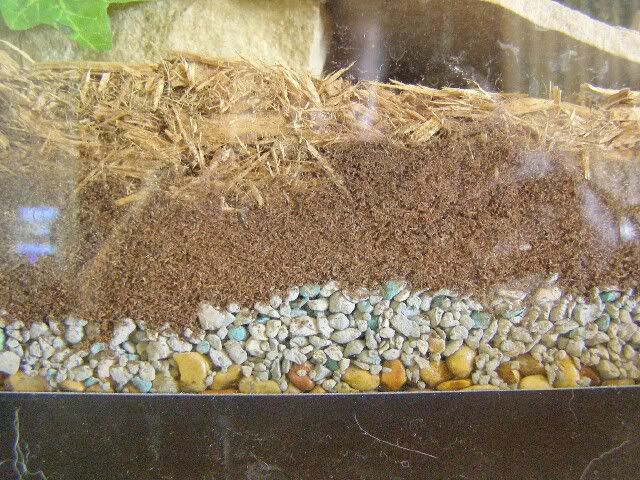Sur un autre site je suis tombé sur le text suivant:
I was in another forum when this question came up...again and again.....I was also having this discussion with a friend of mine who recently acquired an eyelash viper and hates the idea of going into the cage a few times a week.....
I know we are all fanatics about keeping our cages clean, because lets face it if left unclean the bacteria will build up and harm our snakes, lizards, amphibians,.....etc...
but I also get questions from keepers who want to keep showcase style cages fully planted...I have set a few of these up in doctors offices and the like...and here is the formula:
OK kiddies I'm going to let you all in on one of the best kept secrets in herpetoculture.......if you intend to go fully naturalistic you should use a bioactive substrate.....I have done this with all of my display cages (Amazon Tree Boas) and it works wonders especially in our gecko enclosures....
OK so by now your asking what the heck is bioactive substrate? Well bioactive substrate is a substrate that has active bacteria and other microorganisms....
I know what your thinking now isn't bacteria a bad thing? well yes and no there are both bad and beneficial bacteria, and in a boactive substrate beneficial bacteria breaks down waste material and uses it to feed the plants that you have planted in the viv.....
basically you start with plastic egg-crate or a couple inches of washed and dried river pebbles, or my favorite hydroponic clay pellets sometimes called expanded clay aggregate (LECA) in a pinch PLAIN kitty litter (that is bentonite clay unscented fired clay kitty litter) will do...you place this on the bottom of the viv....you then cover this with a layer of plastic/nylon screening material....do not use galvanized steel screen as it will rust on you and throw the natural balance off by throwing too many minerals into the mix.....this is your drainage layer then you want to add roughly two to three inches of sterilized peat moss and for the top layer you will want to add a few inches of either sterilized cypress mulch, fine grade fir bark such as orchid bark, or even shredded coconut will work.....win they have a bowel movement you simply scoop it out with a spoon and stir the substrate at least once a week...you will find your maintenance duties cut in half..this mixture holds moisture well and allows real plants to draw nutrients from the water at the drainage level...plus if you have at Least one side made of glass you can check out the moisture content of your mixture
as your reptile begins to urinate and pass movements in this soil mixture a live bacterial culture will begin to form and eventually become bioactive...it is the same sort of thing that happens in a fish tank filter.....if you really want to get into it you can even add an earthworm or two to complete the mix....
you may want to experiment with various materials and levels depending on the animal being kept...and by all means this is not the only formula
Phillippe de Vosjoli has a chapter on this in his book "The Art of Keeping Snakes"
this has become very popular overseas (Europe) and in a lot of zoo and reptile parks...they just aren't letting the secret out!
Me and my big mouth.....lol
an example

En gros c'est un peu la même méthode qui est utilisé par les gens qui montenet des terra de dendrobathe par exemple...
Est-ce que certains d'entre-vous ont tenté l'expérience?
C'est certain que ça ne conviendrait pas à toutes les espèces à cause de l'humidité et aussi dépendamment de la grosseur du serpent mais pour certains.. (Arboricole surtout) comme un carpet je pense que ça aurait de l'allure non?
Il faudrait s'assurer que le serpent ne passe pas trop son temps sur le substrat humide donc une cachette sur une section de roche par exemple pourrait prévenir les risques d'infection...
C'est pas super pour détecter les paratises non plus mais y'a la quarantaine pour ^ca...